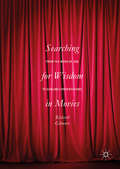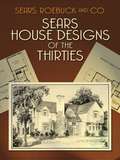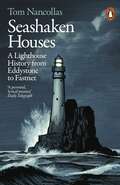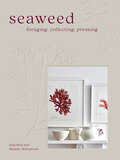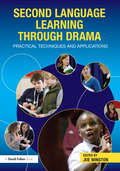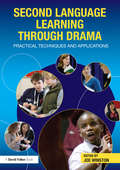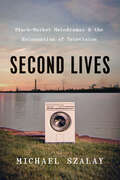- Table View
- List View
The Searchers: The Making of an American Legend
by Glenn FrankelNew York Times BestsellerNamed one of the best books of the year by:ParadeThe GuardianKirkusLibrary Journal The true story behind the classic Western The Searchers by Pulitzer Prize-wining writer Glenn Frankel that the New York Times calls "A vivid, revelatory account of John Ford's 1956 masterpiece."In 1836 in East Texas, nine-year-old Cynthia Ann Parker was kidnapped by Comanches. She was raised by the tribe and eventually became the wife of a warrior. Twenty-four years after her capture, she was reclaimed by the U.S. cavalry and Texas Rangers and restored to her white family, to die in misery and obscurity. Cynthia Ann's story has been told and re-told over generations to become a foundational American tale. The myth gave rise to operas and one-act plays, and in the 1950s to a novel by Alan LeMay, which would be adapted into one of Hollywood's most legendary films, The Searchers, "The Biggest, Roughest, Toughest... and Most Beautiful Picture Ever Made!" directed by John Ford and starring John Wayne. Glenn Frankel, beginning in Hollywood and then returning to the origins of the story, creates a rich and nuanced anatomy of a timeless film and a quintessentially American myth. The dominant story that has emerged departs dramatically from documented history: it is of the inevitable triumph of white civilization, underpinned by anxiety about the sullying of white women by "savages." What makes John Ford's film so powerful, and so important, Frankel argues, is that it both upholds that myth and undermines it, baring the ambiguities surrounding race, sexuality, and violence in the settling of the West and the making of America.
Searching for New Frontiers: Hollywood Films in the 1960s
by Rick WorlandSearching For New Frontiers offers film students and general readers a survey of popular movies of the 1960s. The author explores the most important modes of filmmaking in times that were at once hopeful, exhilarating, and daunting. The text combines discussion of American social and political history and Hollywood industry changes with analysis of some of the era’s most expressive movies. The book covers significant genres and evolving thematic trends, highlighting a variety of movies that confronted the era’s major social issues. It notes the stylistic confluence and exchanges between three forms: the traditional studio movie based on the combination of stars and genres, low-budget exploitation movies, and the international art cinema. As the author reveals, this complex period of American filmmaking was neither random nor the product of unique talents working in a vacuum. The filmmakers met head-on with an evolving American social conscience to create a Hollywood cinema of an era defined by events such as the Vietnam War, the rise of the civil rights movement, and the moon landing.
Searching for New Frontiers: Hollywood Films in the 1960s
by Rick WorlandSearching For New Frontiers offers film students and general readers a survey of popular movies of the 1960s. The author explores the most important modes of filmmaking in times that were at once hopeful, exhilarating, and daunting. The text combines discussion of American social and political history and Hollywood industry changes with analysis of some of the era’s most expressive movies. The book covers significant genres and evolving thematic trends, highlighting a variety of movies that confronted the era’s major social issues. It notes the stylistic confluence and exchanges between three forms: the traditional studio movie based on the combination of stars and genres, low-budget exploitation movies, and the international art cinema. As the author reveals, this complex period of American filmmaking was neither random nor the product of unique talents working in a vacuum. The filmmakers met head-on with an evolving American social conscience to create a Hollywood cinema of an era defined by events such as the Vietnam War, the rise of the civil rights movement, and the moon landing.
Searching for Stars: Stardom and Screen Acting in British Cinema
by Geoffrey MacnabExplores the reasons behind British cinema's failure to create its own stars. The text looks at the way theatre and music hall spawned their stars, and asks why so many of them found the transition to film so awkward. It compares the British star system with that of Hollywood. What sort of contracts were British stars offered? How much were they paid? Who dealt with their publicity? How did Britsh fans regard them? There are essays on key figures (Novello, Fields, Formby, Dors, Bogarde, Mason, Matthews), and assessment of how British stars fared in Hollywood, an analysis of the effects of class and regional prejudice on attempts at British star-making, and a survey of the British comedy tradition, and some of the questions about how genre affected the star system.
Searching for the Just City: Debates in Urban Theory and Practice (Questioning Cities)
by Peter Marcuse James Connolly Johannes Novy Ingrid Olivo Cuz Potter Justin SteilCities are many things. Among their least appealing aspects, cities are frequently characterized by concentrations of insecurity and exploitation. Cities have also long represented promises of opportunity and liberation. Public decision-making in contemporary cities is full of conflict, and principles of justice are rarely the explicit basis for the resolution of disputes. If today’s cities are full of injustices and unrealized promises, how would a Just City function? Is a Just City merely a utopia, or does it have practical relevance? This book engages with the growing debate around these questions. The notion of the Just City emerges from philosophical discussions about what justice is combined with the intellectual history of utopias and ideal cities. The contributors to this volume, including Susan Fainstein, David Harvey and Margit Mayer articulate a conception of the Just City and then examine it from differing angles, ranging from Marxist thought to communicative theory. The arguments both develop the concept of a Just City and question it, as well as suggesting alternatives for future expansion. Explorations of the concept in practice include case studies primarily from U.S. cities, but also from Europe, the Middle East and Latin America. The authors find that a forthright call for justice in all aspects of city life, putting the question of what a Just City should be on the agenda of urban reform, can be a practical approach to solving questions of urban policy. This synthesis is provocative in a globalised world and the contributing authors bridge the gap between theoretical conceptualizations of urban justice and the reality of planning and building cities. The notion of the Just City is an empowering framework for contemporary urban actors to improve the quality of urban life and Searching for the Just City is a seminal read for practitioners, professionals, students, researchers and anyone interested in what urban futures should aim to achieve.
Searching for the Just City: Debates in Urban Theory and Practice (Questioning Cities)
by Peter Marcuse, James Connolly, Johannes Novy, Ingrid Olivo, Cuz Potter and Justin SteilCities are many things. Among their least appealing aspects, cities are frequently characterized by concentrations of insecurity and exploitation. Cities have also long represented promises of opportunity and liberation. Public decision-making in contemporary cities is full of conflict, and principles of justice are rarely the explicit basis for the resolution of disputes. If today’s cities are full of injustices and unrealized promises, how would a Just City function? Is a Just City merely a utopia, or does it have practical relevance? This book engages with the growing debate around these questions. The notion of the Just City emerges from philosophical discussions about what justice is combined with the intellectual history of utopias and ideal cities. The contributors to this volume, including Susan Fainstein, David Harvey and Margit Mayer articulate a conception of the Just City and then examine it from differing angles, ranging from Marxist thought to communicative theory. The arguments both develop the concept of a Just City and question it, as well as suggesting alternatives for future expansion. Explorations of the concept in practice include case studies primarily from U.S. cities, but also from Europe, the Middle East and Latin America. The authors find that a forthright call for justice in all aspects of city life, putting the question of what a Just City should be on the agenda of urban reform, can be a practical approach to solving questions of urban policy. This synthesis is provocative in a globalised world and the contributing authors bridge the gap between theoretical conceptualizations of urban justice and the reality of planning and building cities. The notion of the Just City is an empowering framework for contemporary urban actors to improve the quality of urban life and Searching for the Just City is a seminal read for practitioners, professionals, students, researchers and anyone interested in what urban futures should aim to achieve.
Searching for Wisdom In Movies: From the Book of Job to Sublime Conversations
by Richard GilmoreIn this volume, Richard Gilmore explores film as a channel through which to engage in philosophical reflection and analyzes the relationship between philosophy and film. This book argues that philosophy and film can and should be used for the amelioration of life’s difficulties and the promotion of life’s boons. Gilmore identifies how philosophy and film complement and enrich one another and explores their relationship by connecting classic wisdom texts to significant movies. For example, the volume analyzes the Coen brothers’ films The Big Lebowski and A Serious Man in light of The Book of Job. Gilmore considers the ancient idea of philosophy as “spiritual exercise” and a way of life. The volume concludes by examining what the author labels “sublime conversations” as the highest expression of philosophy. The book identifies and dissects these conversations in movies directed by the likes of Robert Bresson, Yasujirō Ozu, Jean-Luc Godard, and Ingmar Bergman, among others.
Searching for Wisdom In Movies: From the Book of Job to Sublime Conversations
by Richard GilmoreIn this volume, Richard Gilmore explores film as a channel through which to engage in philosophical reflection and analyzes the relationship between philosophy and film. This book argues that philosophy and film can and should be used for the amelioration of life’s difficulties and the promotion of life’s boons. Gilmore identifies how philosophy and film complement and enrich one another and explores their relationship by connecting classic wisdom texts to significant movies. For example, the volume analyzes the Coen brothers’ films The Big Lebowski and A Serious Man in light of The Book of Job. Gilmore considers the ancient idea of philosophy as “spiritual exercise” and a way of life. The volume concludes by examining what the author labels “sublime conversations” as the highest expression of philosophy. The book identifies and dissects these conversations in movies directed by the likes of Robert Bresson, Yasujirō Ozu, Jean-Luc Godard, and Ingmar Bergman, among others.
Searching Multimedia Databases by Content (Advances in Database Systems #3)
by Christos FaloutsosSearching Multimedia Databases by Content bridges the gap between the database and signal processing communities by providing the necessary background information for the reader and presenting it along with the intuition and mechanics of the best existing tools in each area. The first half of Searching Multimedia Databases by Content reviews the most successful database access methods, in increasing complexity, reaching up to spatial access methods and text retrieval. In all cases, the emphasis is on practical approaches that have been incorporated in commercial systems, or that seem very promising. The second half of the book uses the above access methods to achieve fast searching in a database of signals. A general methodology is presented, which suggests extracting a few good features from each multimedia object, thus mapping objects into points in a metric space. Finally, the book concludes by presenting some recent successful applications of the methodology on time series and color images. Searching Multimedia Databases by Content is targeted towards researchers and developers of multimedia systems. The book can also serve as a textbook for a graduate course on multimedia searching, covering both access methods as well as the basics of signal processing.
Sears House Designs of the Thirties (Dover Architecture Ser.)
by Roebuck Sears Co.Proudly promoting itself as "the largest home building organization in the world," Sears, Roebuck and Company advertised in 1932 products in a handsome catalog that also displayed a full-size replica of Mount Vernon, created from Sears materials for a Paris exposition in 1932.At the heart of this now-rare publication were measured floor plans for 68 Sears homes. Over 200 illustration displayed interiors and exteriors for such handsome residences as the Belmont, a six-room house with vestibule, breakfast alcove, three bedrooms, and one-and-a-half baths; and the Dover, an English-styled cottage with a massive chimney and unusual roof lines. Photographs of some interiors revealed a furnished living room with paneled side walls and hewed oak ceiling beams; a spacious kitchen with contemporary appliances; a 60-foot living room with a huge stone fireplace, built-in bookshelves, a vaulted ceiling, and other designs.An invaluable sourcebook for restorationists, this handsome volume will also be of use to people interested in preserving homes of the period. It will be welcomed by anyone who relishes a glimpse of America's architectural past.
Sears Modern Homes, 1913 (Dover Architecture Ser.)
by Roebuck Sears Co.For thousands of Americans, catalogs such as Sears' Modern Homes were the first step in realizing their dreams of owning a home. Reproduced from a rare 1913 edition, this volume features 112 designs for homes of "comfort and refinement." These authentic plans offer a wealth of information on building materials and other details, along with external views, floor plans, descriptions with prices, and more. Antique collectors, home hobbyists, and fans of traditional design will find this book a bountiful resource for valuable tips on building and restoration.
Seashaken Houses: A Lighthouse History from Eddystone to Fastnet
by Tom NancollasLighthouses are striking totems of our relationship to the sea. For many, they encapsulate a romantic vision of solitary homes amongst the waves, but their original purpose is much more utilitarian than that. Still today we depend upon their guiding lights for the safe passage of ships. Nowhere is this truer than in the rock lighthouses of Great Britain and Ireland, a ring of 19 towers built between 1811-1905, so-called because they were constructed on desolate rock formations in the middle of the sea, and made of granite to withstand the power of its waves.Seashaken Houses is a lyrical exploration of these singular towers, the people who risked their lives building and rebuilding them, those that inhabited their circular rooms, and the ways in which we value emblems of our history in a changing world.
Seaside Building Design: Buildings in Maritime Zones (Innovative Renewable Energy)
by Ali SayighThis one of a kind reference gathers numerous new studies examining the design of buildings in seaside locations. Chapters discuss design for various locations and seaside climates and include information regarding climate, materials, concepts of cooling and heating, vegetation and micro-climate, and weather conditions and sustainability. This book provides architects, engineers, builders, and students with design examples and applications that will enable them to design and build comfortable, cost-effective and sustainable buildings in maritime zones.
Seasonal Affective Disorder and Light Therapy: Using Human-Centered Design to Treat Winter Depression (BestMasters)
by Jannik GötzJannik Götz develops a treatment concept for sufferers of Seasonal Affective Disorder, commonly known as winter depression. Unlike existing solutions that focus on medical remission only, the author aims at creating a user experience that is alleviating symptoms of this disease in a motivating and hassle-free way. By utilizing a variety of research techniques, the author gains valuable user-driven insights that are directly transformed into a novel approach to light therapy. The result is a light lamp that resolves shortcomings and issues of current treatment approaches. A business plan and its associated requirements complement the overall concept.
Seasons for the Soul - Spells of Nature: The Embroidered Art of Julia van den Bosch
by Julia van den BoschThe beauty and magic of nature seen through the eye of a needle. Colours of flowers and shapes of plants; bleached grass and golden cornfields at harvest time; spiders webs on the structures of decayed seedheads; a metallic green chafer beetle landing on a deep crimson rose; a shooting star. Beguiling discoveries that are part of the world full of secrets, minute details and the sumptuous colours and textures of nature that lend themselves to their translation into rich embroidery. This embroidered path of the seasons uses hand embroidery in its traditional role of storytelling to share nature's gifts. Each stitch holds the emotion of the moment and keeps a record. The book tells the story of the companionship and healing offered by the seasons during the enforced isolation of the pandemic, and how it enabled the artist to find beauty in solitude.
Season's Greetings
by Alan AyckbournNow we don't want to start Christmas like this, do we?Cheating at snakes and ladders, fighting over comic books, a bungled infidelity beneath the tree. Christmas has arrived in the Bunker household along with family and friends. But as the children lurk just out of sight, it's the adults who are letting the side down. I couldn't. Not in our sitting-room. Not in front of the television. Somewhere else. Presiding over the festivities are two warring uncles, one a kindly, incompetent doctor with an interminable puppet show to perform; the other a bullying retired security guard who dominates the TV, brings toy guns for his nieces and determines there's a thief in their midst. Alan Ayckbourn's masterly Season's Greetings offers a seriously entertaining look at the misery and high jinks of an average family Christmas. The play opens at the National Theatre, London, in December 2010.Three times I caught him at it. Ripping open presents, helping himself to the contents.
A seated male nude twisting around (tactile)
by RnibAbout 1504-1505. Pen and brown ink, brown and grey wash, heightened with lead white (partly discoloured) over leadpoint and stylus. Size: 42.1 x 28.7 cm. British Museum, PD 1887-5-2-116. This is one of several drawings exhibited here for Michelangelo's ""Bathers"" cartoon, the centrepiece of the never executed fresco of the Battle of Cascina for the Palazzo Vecchio, Florence. This is a life study for the pivotal figure seated at the centre of the composition. The way Michelangelo has used pen and white heightening to describe the model's glistening limbs is highly effective. However, his use of wash for the shaded area is less successful. This drawing shows a seated male nude with his legs and knees facing the viewer but with torso and head turned away from the viewer. His right arm is bent at the elbow and is raised to head height. His left arm is not shown as this is out of sight behind his torso. The figure's right leg is bent at the knee and is resting on the seat. The detail on the drawing is concentrated on the legs and twisting torso. The head and right hand are less defined, with the seat barely shown. The tactile image shows an outline of the figure defined by thick lines with muscle tone shown as rough texture. Thin lines give an idea where the seat is. Braille labels have been added: head, shoulder, right arm, buttocks, right leg, left leg and seat.
Seaweed: Foraging, Collecting, Pressing
by Melanie Molesworth Julia BirdA gorgeous guide to foraging, pressing and using seaweeds for a wealth of home creative projects. Both aspirational and inspirational, this guide to bringing the outdoors inside is quite unlike anything on the market and will inspire all readers to begin their beach foraging journey.
Second Century of the Skyscraper: Council on Tall Buildings and Urban Habitat
by Council on Tall Buildings & Urbantenant is looming in importance. The owner is having more influence on the building. As Gerald D. Hines has said, there are indications that the desire for more discretionary time will lead to more residential high-rises dose to or in the midst of downtown office buildings. Downtown living could become the desired alternative. Tall buildings will be approached increasingly from the standpoint of an urban ecology - that what happens to apart can influence the whole. Provid ing for public as well as private needs in a tall building project is just one example (facilities for schools, shops, religious, and other needs). More attention will be paid to maintaining streets as lively and interesting places. Will a new "world's tallest" be built? Will we go a mile high? The answer is probably "yes" to the first, "no" to the second. With the recent spate of super-tall buildings on the drawing boards, going to greater heights was in the back of many people's minds at the Chicago conference. But in the U nited States, at least, buildings of 70 to 80 stories would appear to provide needed space consistent with economy. The future, then, is described in depth by papers that go into specific areas.
Second Chance: My Life in Things
by Ruth RosengartenIn this intimate memoir, Ruth Rosengarten explores the subject of evocative objects through a series of interconnected essays. Evocative objects reflect our attitudes to our own lives and how we seek to display ourselves to ourselves. They are therefore, closely linked to our memories, and how we filter, process and reconstruct them. Rosengarten explores the themes and associations invoked by her own evocative objects, which are frequently shabby things of no material value. They are, importantly, often objects that, in their materiality, bear traces of actions, of something-having-been. Through the associative pathways that these objects have paved, she discusses her experiences with the losses she has undergone, her family’s migrations, and what it means to be a childless woman. This leads her to address the question of what will become of her storied objects and the memories attached to them when she is no longer in existence. This memoir offers an interdisciplinary approach to collecting and compiling fragments of one’s life, paying close attention to the evocative objects that embody us. In doing so, these essays explore loss, memory, childlessness, longing, family history, literature and art theory through material entities which reveal the immaterial ‘things’ at the heart of this study. This book is sure to be of interest to anyone stimulated by memory work and the relationship between humans and their possessions.
Second International Conference on Image Processing and Capsule Networks: ICIPCN 2021 (Lecture Notes in Networks and Systems #300)
by Joy Iong-Zong Chen João Manuel R. S. Tavares Abdullah M. Iliyasu Ke-Lin DuThis book includes the papers presented in 2nd International Conference on Image Processing and Capsule Networks [ICIPCN 2021]. In this digital era, image processing plays a significant role in wide range of real-time applications like sensing, automation, health care, industries etc. Today, with many technological advances, many state-of-the-art techniques are integrated with image processing domain to enhance its adaptiveness, reliability, accuracy and efficiency. With the advent of intelligent technologies like machine learning especially deep learning, the imaging system can make decisions more and more accurately. Moreover, the application of deep learning will also help to identify the hidden information in volumetric images. Nevertheless, capsule network, a type of deep neural network, is revolutionizing the image processing domain; it is still in a research and development phase. In this perspective, this book includes the state-of-the-art research works that integrate intelligent techniques with image processing models, and also, it reports the recent advancements in image processing techniques. Also, this book includes the novel tools and techniques for deploying real-time image processing applications.The chapters will briefly discuss about the intelligent image processing technologies, which leverage an authoritative and detailed representation by delivering an enhanced image and video recognition and adaptive processing mechanisms, which may clearly define the image and the family of image processing techniques and applications that are closely related to the humanistic way of thinking.
Second Language Learning through Drama: Practical Techniques and Applications
by Joe WinstonDrama is increasingly being recognised as a valuable pedagogy for language learning as it can harness children‘s imaginations and stimulate their desire to communicate. Second Learning Language through Drama draws on current theories of additional and foreign language learning and illustrates through practical case studies how drama can be used to support the four key skills of listening, speaking, reading and writing. Drawing on the work of an international group of practitioners who are all highly experienced in using drama for the purpose of second language learning, the book clearly explains key drama conventions and strategies and outlines the innovative ways they have been used to create enjoyable and stimulating classroom activities that allow for multiple ways of learning. Throughout the book the emphasis is on making language learning accessible and relevant to children and young people through creative, physically active and playful approaches. The strategies described are all highly flexible and readily adaptable to different teaching contexts. Specific themes include: Using stories and drama to motivate learners at all levels Drama, language learning and identity Assessment opportunities through process drama Issues of language learning and cultural empowerment Digital storytelling Film & drama aesthetics Second Language Learning through Drama will be of great interest to those studying on undergraduate and postgraduate courses and will serve as a highly valuable text to practitioners looking to incorporate the approaches described into their lessons and classroom activities.
Second Language Learning through Drama: Practical Techniques and Applications
by Joe WinstonDrama is increasingly being recognised as a valuable pedagogy for language learning as it can harness children‘s imaginations and stimulate their desire to communicate. Second Learning Language through Drama draws on current theories of additional and foreign language learning and illustrates through practical case studies how drama can be used to support the four key skills of listening, speaking, reading and writing. Drawing on the work of an international group of practitioners who are all highly experienced in using drama for the purpose of second language learning, the book clearly explains key drama conventions and strategies and outlines the innovative ways they have been used to create enjoyable and stimulating classroom activities that allow for multiple ways of learning. Throughout the book the emphasis is on making language learning accessible and relevant to children and young people through creative, physically active and playful approaches. The strategies described are all highly flexible and readily adaptable to different teaching contexts. Specific themes include: Using stories and drama to motivate learners at all levels Drama, language learning and identity Assessment opportunities through process drama Issues of language learning and cultural empowerment Digital storytelling Film & drama aesthetics Second Language Learning through Drama will be of great interest to those studying on undergraduate and postgraduate courses and will serve as a highly valuable text to practitioners looking to incorporate the approaches described into their lessons and classroom activities.
Second Lives: Black-Market Melodramas and the Reinvention of Television
by Michael SzalayA history of prestige television through the rise of the “black-market melodrama.” In Second Lives, Michael Szalay defines a new television genre that has driven the breathtaking ascent of TV as a cultural force over the last two decades: the black-market melodrama. Exemplified by the likes of The Sopranos and Breaking Bad, the genre moves between a family’s everyday life and its secret second life, which may involve illegal business, espionage, or even an alternate reality. Second lives allow characters (and audiences) to escape what feels like endless work into a revanchist vision of the white middle class family. But there is for this grimly resigned genre no meaningful way back to the Fordist family wage for which it longs. In fact, Szalay argues, black-market melodramas lament the very economic transformations that untethered TV viewing from the daily rhythms of the nine-to-five job and led, ultimately, to prestige TV.
Second Lives: Black-Market Melodramas and the Reinvention of Television
by Michael SzalayA history of prestige television through the rise of the “black-market melodrama.” In Second Lives, Michael Szalay defines a new television genre that has driven the breathtaking ascent of TV as a cultural force over the last two decades: the black-market melodrama. Exemplified by the likes of The Sopranos and Breaking Bad, the genre moves between a family’s everyday life and its secret second life, which may involve illegal business, espionage, or even an alternate reality. Second lives allow characters (and audiences) to escape what feels like endless work into a revanchist vision of the white middle class family. But there is for this grimly resigned genre no meaningful way back to the Fordist family wage for which it longs. In fact, Szalay argues, black-market melodramas lament the very economic transformations that untethered TV viewing from the daily rhythms of the nine-to-five job and led, ultimately, to prestige TV.




